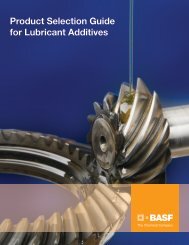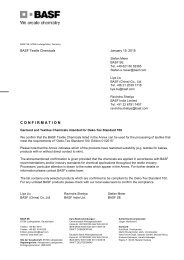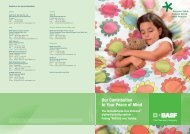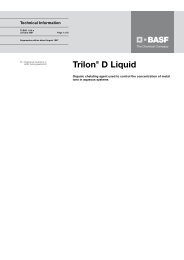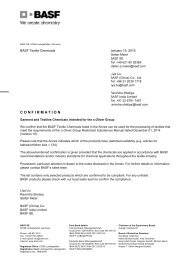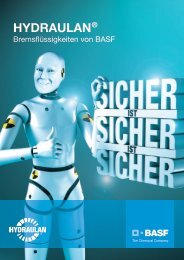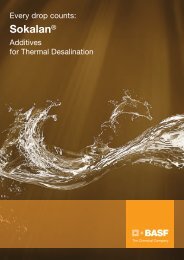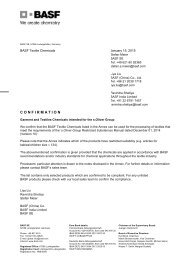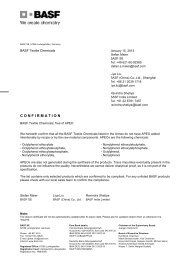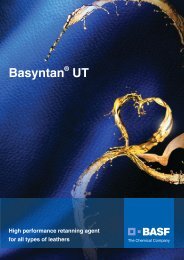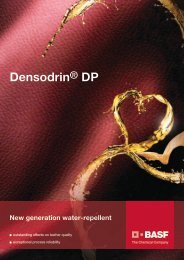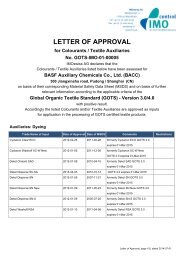Carbon footprint – a new challenge for the leather industry
Carbon footprint – a new challenge for the leather industry
Carbon footprint – a new challenge for the leather industry
Create successful ePaper yourself
Turn your PDF publications into a flip-book with our unique Google optimized e-Paper software.
Technology<br />
generated by companies along <strong>the</strong> value creation chain<br />
in<strong>for</strong>mative, practical and uni<strong>for</strong>m.<br />
In 2010, BASF achieved significant reductions in greenhouse<br />
gas emissions from its own production from 31.1 million tons in<br />
2009 to 25.2 million tons in 2010. The company’s innovative<br />
climate protection solutions across all industries helped<br />
customers to reduce <strong>the</strong>ir CO 2 <strong>footprint</strong> by 322 million tons.<br />
In principle, every branch of <strong>industry</strong> is affected by discussions<br />
concerning carbon <strong>footprint</strong>s, but <strong>the</strong> automotive <strong>industry</strong> is in<br />
<strong>the</strong> focus of <strong>the</strong>se <strong>challenge</strong>s. Internal combustion engines are<br />
responsible <strong>for</strong> a large proportion of CO 2 emissions. This is<br />
reflected in <strong>the</strong> ef<strong>for</strong>ts of many motor manufacturers to develop<br />
alternative means of propulsion that are as close as possible to<br />
being carbon neutral. If <strong>the</strong> whole automotive value chain is<br />
analyzed, it can be estimated that approximately 80% of <strong>the</strong><br />
carbon <strong>footprint</strong> is accounted <strong>for</strong> in <strong>the</strong> active use phase, that is,<br />
when <strong>the</strong> vehicle is being driven. Five percent of carbon<br />
emissions are generated when <strong>the</strong> vehicle is disposed of and 15%<br />
when it is manufactured.<br />
In Germany and some o<strong>the</strong>r countries, manufacturers already<br />
in<strong>for</strong>m consumers about <strong>the</strong> CO 2 that is emitted in <strong>the</strong> active use<br />
phase in g CO 2 per km. In future, motor manufacturers will<br />
collect in<strong>for</strong>mation on <strong>the</strong> CO 2 emissions of all <strong>the</strong> components<br />
and <strong>the</strong>y will need to request this in<strong>for</strong>mation from <strong>the</strong>ir<br />
suppliers. The lea<strong>the</strong>r <strong>industry</strong> will <strong>the</strong>re<strong>for</strong>e need to respond to<br />
<strong>the</strong> <strong>challenge</strong> of quantifying CO 2 emissions per m 2 of lea<strong>the</strong>r.<br />
Panel 3:<br />
Disposal of <strong>the</strong> hides generates additional CO 2 emissions and<br />
utilizing <strong>the</strong>m to manufacture lea<strong>the</strong>r products <strong>for</strong> o<strong>the</strong>r<br />
applications would be a more sustainable alternative.<br />
There are different approaches to evaluate <strong>the</strong> carbon <strong>footprint</strong><br />
of lea<strong>the</strong>r articles. One approach would be to determine <strong>the</strong><br />
carbon <strong>footprint</strong> of every type of lea<strong>the</strong>r manufactured by <strong>the</strong><br />
tannery. This method is cumbersome and requires a lot of time<br />
and ef<strong>for</strong>t, which makes it unfeasible. Ano<strong>the</strong>r approach is <strong>the</strong><br />
cradle-to-grave approach, which is to per<strong>for</strong>m an entire lifecycle<br />
assessment, covering all <strong>the</strong> stages of <strong>the</strong> product life from raw<br />
material to disposal. This approach is complicated and<br />
impractical <strong>for</strong> use in <strong>the</strong> lea<strong>the</strong>r <strong>industry</strong>.<br />
Currently, <strong>the</strong> most practicable solution would be to calculate<br />
<strong>the</strong> corporate carbon <strong>footprint</strong> (CCF) by measuring <strong>the</strong><br />
greenhouse gases emitted at each production site, <strong>the</strong>n expressed<br />
as <strong>the</strong> CO 2 equivalent. This figure can <strong>the</strong>n be expressed relative<br />
to <strong>the</strong> surface area of <strong>the</strong> lea<strong>the</strong>r that is produced in <strong>the</strong> tannery.<br />
The final figure is an average <strong>for</strong> each production site, which is<br />
certainly enough to satisfy <strong>the</strong> requirements of <strong>the</strong> automotive<br />
<strong>industry</strong> and <strong>the</strong> shoe <strong>industry</strong>.<br />
The scope of <strong>the</strong> CCF has to be clearly defined, i.e. it needs to<br />
specify exactly which statistics from <strong>the</strong> production plant are<br />
included in <strong>the</strong> calculation. The German Lea<strong>the</strong>r Federation has<br />
developed a method (ECO 2 L-Label) which is currently being<br />
introduced. This offers tanners a ra<strong>the</strong>r simple means of<br />
measuring a clearly defined, standardized carbon <strong>footprint</strong>. The<br />
ECO 2 L-Label may be adopted as an international standard.<br />
The factors <strong>for</strong> determining <strong>the</strong> carbon <strong>footprint</strong> of<br />
lea<strong>the</strong>r<br />
In principle, a distinction needs to be made between three<br />
separate segments:<br />
1] The production of <strong>the</strong> lea<strong>the</strong>r in <strong>the</strong> tannery (see ECO 2 L-Label):<br />
In particular this includes <strong>the</strong> type and quantity of energy<br />
consumed in <strong>the</strong> tannery and in <strong>the</strong> transport and disposal of<br />
goods. This phase is well covered by <strong>the</strong> <strong>new</strong> label.<br />
2] The production of chemicals: This includes both <strong>the</strong> basic<br />
chemicals as well as <strong>the</strong> specialties that are applied to <strong>the</strong><br />
Panel 4:<br />
The <strong>Carbon</strong> Footprint<br />
Several different approaches can be taken to define and<br />
quantify <strong>the</strong> carbon <strong>footprint</strong> of lea<strong>the</strong>r. In principle, <strong>the</strong> carbon<br />
<strong>footprint</strong> of lea<strong>the</strong>r ought to be calculated <strong>for</strong> <strong>the</strong> whole of its<br />
lifecycle. Because lea<strong>the</strong>r is made from hide - which is obtained<br />
as a by-product of meat production - <strong>the</strong> carbon <strong>footprint</strong> of<br />
cattle-breeding needs to be taken into account, in particular, <strong>the</strong><br />
methane gas that is generated as a fermentation product in <strong>the</strong><br />
digestive systems of ruminants.<br />
Because <strong>the</strong> raw hide is clearly a by-product of <strong>the</strong> production<br />
of meat and milk, it is not directly responsible <strong>for</strong> <strong>the</strong> methane<br />
that is emitted as <strong>the</strong> result of raising cattle.<br />
Never<strong>the</strong>less, it has not yet been clearly defined how <strong>the</strong>se<br />
emissions should be allocated in <strong>the</strong> production of lea<strong>the</strong>r.<br />
WORLD LEATHER FEBRUARY/MARCH 2012<br />
XX



